Silence and Awareness as part of the Natural Healing Process
It often happens that when patients are done with their osteopathic manipulation, they get off the table and ponder – how does that work. So little effort comes from the doctor of osteopathy’s hands, yet they are completely relaxed and feel aligned. As important to osteopathic manipulative treatment is physically aligning the body, the manner-in-which the doctor of osteopathy proceeds is every bit as important. Andrew Taylor Still, the profession’s founder and first doctor of osteopathy, talked about finding the health within the patient and using it to help them get well. Osteopathic manipulative treatment (OMT) facilitates the union between the lesion field and the health by connecting with the patient through a physical contact that holds the lesion at a physiologic balance while their awareness is grounded in silence. With their awareness grounded in silence, the doctor of osteopathy can perceive the patient’s health at work. Before the doctor of osteopathy proceeds, he must first be silent and aware.
Thus, learning more about silence and awareness and how to put this understanding to use is an all-important mission. I have found the following excerpt to have been very insightful.
Meaningful guidance on silence and awareness is sparse and hard to come by. Martin Laird does an excellent job of bringing out qualities of silence and awareness in his book: A Sunlit Absence – Silence, Awareness, and Contemplation by Martin Laird, Oxford University Press:
Excerpts from chapter 3: On Silence and Noise
…
With hopes of teaching them all how to draw, Kathleen Norris stands before her classroom of elementary school students. She recounts in Amazing Grace her remarkable way of going about this. Before teaching them to draw, she first needs to teach them how to be silent and aware. She explains to the class that when she raises her hand they are to make as much noise as they possibly can, but when she lowers her hand, they must all be completely silent. No noise, no movement, no making funny faces. The lesson begins: she raises her hand, and an almighty racket ensues. But as soon as she drops her hand the noise indeed stops instantly. They were “so still," she says, "that silence became a presence in the classroom.” What fascinates Norris most is how the “silence liberated the imagination of so many children.” Her simple exercise with these school children shows us something important about the nature of silence. Silence is not simply about the absence of sound waves. It is concerned with attention and awareness. Silence and awareness are in fact one thing.
…
Stretches of physical silence and contemplation, especially on a daily basis, help destress the nervous system. While the constant stimulation of the noise of everyday life keeps anxiety levels high and our attention fixed on objects that we are (more or less) aware of, whether an exterior object such as computer screen or an interior object such as thought or feeling or mind-tripping inner video.
…
If we know how to dwell in physical silence, then silence becomes not a threat but attractive, nurturing, and liberating. The powerful attraction of something as utterly simple as silence is well attested throughout the contemplative tradition.
…
The twentieth-century Swiss psychoanalyst C.G. Jung apparently knew this, and today medicine has discovered the practice of contemplation to be an effective destressor, with direct bearing on weight control, blood pressure, and much more. There is a story told of how Jung used silence to help one of his patients become aware of the cause of his problems. Complaining of a general anxiety, but unable to identify what he was anxious about, the client did not give Jung much to work with. Jung suggested he go home and spend the evenings alone and see what came up before their next appointment the following week. The man returned and told Jung that he had enjoyed the evenings alone at home; he had read a novel he had been meaning to read for months and listened to symphonies he had not enjoyed for years. Jung said, “Ah! I didn’t mean go home and read or listen to music just now. I mean go home during the evenings and just be silent.’ And so, the man went home and did just that. When he returned the following week, he had plenty that he could begin to talk about. The silence had begun to draw out some of the problems that underlay this man’s anxiety so that he could now begin to address them. Silence is sometimes like a poultice placed over a sore to draw out infection as part of the healing process.

